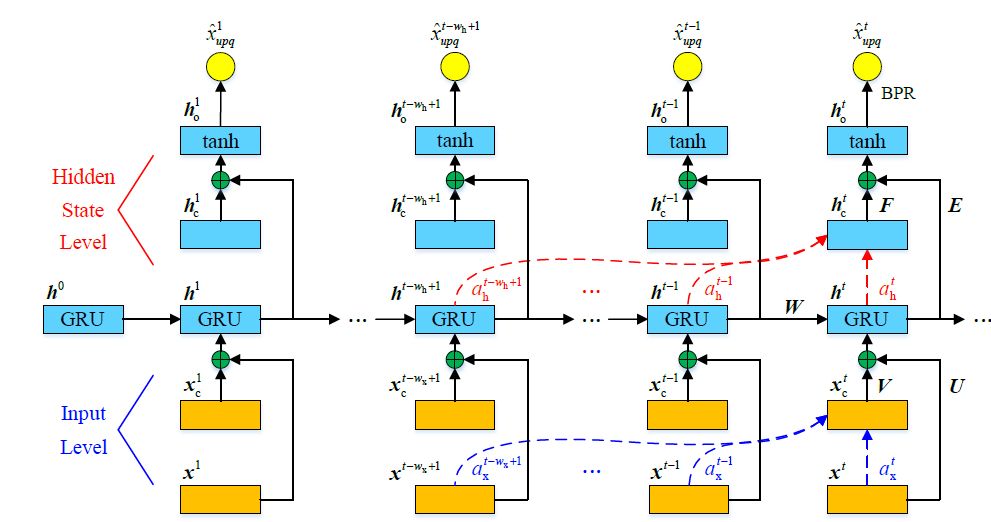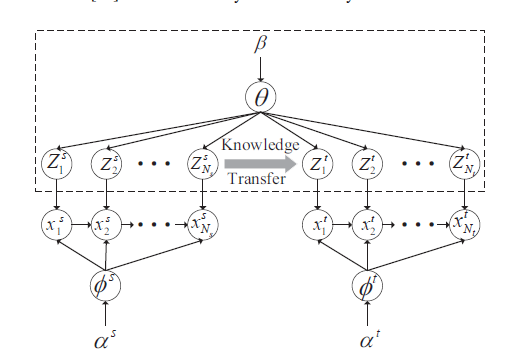【论文推荐】最新六篇序列推荐相关论文—卷积序列嵌入学习、用户记忆网络、上下文GRU、迁移学习
【导读】专知内容组整理了最近五篇序列推荐(Sequential Recommendation)相关文章,为大家进行介绍,欢迎查看!
1. Personalized Top-N Sequential Recommendation via Convolutional Sequence Embedding
作者:Jiaxi Tang ,Ke Wang
摘要:Top-N sequential recommendation models each user as a sequence of items interacted in the past and aims to predict top-N ranked items that a user will likely interact in a »near future». The order of interaction implies that sequential patterns play an important role where more recent items in a sequence have a larger impact on the next item. In this paper, we propose a Convolutional Sequence Embedding Recommendation Model »Caser» as a solution to address this requirement. The idea is to embed a sequence of recent items into an »image» in the time and latent spaces and learn sequential patterns as local features of the image using convolutional filters. This approach provides a unified and flexible network structure for capturing both general preferences and sequential patterns. The experiments on public data sets demonstrated that Caser consistently outperforms state-of-the-art sequential recommendation methods on a variety of common evaluation metrics.
期刊:WSDM 2018
网址:
https://dl.acm.org/citation.cfm?id=3159656
2. Sequential Recommendation with User Memory Networks
作者:Xu Chen, Hongteng Xu, Yongfeng Zhang, Jiaxi Tang, Yixin Cao, Zheng Qin, Hongyuan Zha
摘要:User preferences are usually dynamic in real-world recommender systems, and a user»s historical behavior records may not be equally important when predicting his/her future interests. Existing recommendation algorithms -- including both shallow and deep approaches -- usually embed a user»s historical records into a single latent vector/representation, which may have lost the per item- or feature-level correlations between a user»s historical records and future interests. In this paper, we aim to express, store, and manipulate users» historical records in a more explicit, dynamic, and effective manner. To do so, we introduce the memory mechanism to recommender systems. Specifically, we design a memory-augmented neural network (MANN) integrated with the insights of collaborative filtering for recommendation. By leveraging the external memory matrix in MANN, we store and update users» historical records explicitly, which enhances the expressiveness of the model. We further adapt our framework to both item- and feature-level versions, and design the corresponding memory reading/writing operations according to the nature of personalized recommendation scenarios. Compared with state-of-the-art methods that consider users» sequential behavior for recommendation, e.g., sequential recommenders with recurrent neural networks (RNN) or Markov chains, our method achieves significantly and consistently better performance on four real-world datasets. Moreover, experimental analyses show that our method is able to extract the intuitive patterns of how users» future actions are affected by previous behaviors.
期刊:WSDM 2018
网址:
https://dl.acm.org/citation.cfm?id=3159668
3. A Hierarchical Contextual Attention-based GRU Network for Sequential Recommendation
作者:Qiang Cui,Shu Wu,Yan Huang,Liang Wang
摘要:Sequential recommendation is one of fundamental tasks for Web applications. Previous methods are mostly based on Markov chains with a strong Markov assumption. Recently, recurrent neural networks (RNNs) are getting more and more popular and has demonstrated its effectiveness in many tasks. The last hidden state is usually applied as the sequence's representation to make recommendation. Benefit from the natural characteristics of RNN, the hidden state is a combination of long-term dependency and short-term interest to some degrees. However, the monotonic temporal dependency of RNN impairs the user's short-term interest. Consequently, the hidden state is not sufficient to reflect the user's final interest. In this work, to deal with this problem, we propose a Hierarchical Contextual Attention-based GRU (HCA-GRU) network. The first level of HCA-GRU is conducted on the input. We construct a contextual input by using several recent inputs based on the attention mechanism. This can model the complicated correlations among recent items and strengthen the hidden state. The second level is executed on the hidden state. We fuse the current hidden state and a contextual hidden state built by the attention mechanism, which leads to a more suitable user's overall interest. Experiments on two real-world datasets show that HCA-GRU can effectively generate the personalized ranking list and achieve significant improvement.
期刊:arXiv, 2018年2月5日
网址:
http://www.zhuanzhi.ai/document/9949bd700b0c5da7ef4c7083bbd69470
4. Cross-domain novelty seeking trait mining for sequential recommendation
作者:Fuzhen Zhuang,Yingmin Zhou,Fuzheng Zhang,Xiang Ao,Xing Xie,Qing He
摘要:Transfer learning has attracted a large amount of interest and research in last decades, and some efforts have been made to build more precise recommendation systems. Most previous transfer recommendation systems assume that the target domain shares the same/similar rating patterns with the auxiliary source domain, which is used to improve the recommendation performance. However, to the best of our knowledge, almost these works do not consider the characteristics of sequential data. In this paper, we study the new cross-domain recommendation scenario for mining novelty-seeking trait. Recent studies in psychology suggest that novelty-seeking trait is highly related to consumer behavior, which has a profound business impact on online recommendation. Previous work performing on only one single target domain may not fully characterize users' novelty-seeking trait well due to the data scarcity and sparsity, leading to the poor recommendation performance. Along this line, we proposed a new cross-domain novelty-seeking trait mining model (CDNST for short) to improve the sequential recommendation performance by transferring the knowledge from auxiliary source domain. We conduct systematic experiments on three domain data sets crawled from Douban (www.douban.com) to demonstrate the effectiveness of the proposed model. Moreover, we analyze how the temporal property of sequential data affects the performance of CDNST, and conduct simulation experiments to validate our analysis.
期刊:arXiv, 2018年3月5日
网址:
http://www.zhuanzhi.ai/document/1143ae49978597371e5d852b21b4879a
5. SAR: Semantic Analysis for Recommendation
作者:Han Xiao, Lian Meng, Minlie Huang, Xiaoyan Zhu
摘要:Recommendation system is a common demand in daily life and matrix completion is a widely adopted technique for this task. However, most matrix completion methods lack semantic interpretation and usually result in weak-semantic recommendations. To this end, this paper proposes a
期刊:arXiv, 2018年12月2日
网址:
http://www.zhuanzhi.ai/document/0ba98c6f13072180181ce489e36bee34
-END-
专 · 知
人工智能领域主题知识资料查看获取:【专知荟萃】人工智能领域26个主题知识资料全集(入门/进阶/论文/综述/视频/专家等)
同时欢迎各位用户进行专知投稿,详情请点击:
【诚邀】专知诚挚邀请各位专业者加入AI创作者计划!了解使用专知!
请PC登录www.zhuanzhi.ai或者点击阅读原文,注册登录专知,获取更多AI知识资料!
请扫一扫如下二维码关注我们的公众号,获取人工智能的专业知识!
请加专知小助手微信(Rancho_Fang),加入专知主题人工智能群交流!加入专知主题群(请备注主题类型:AI、NLP、CV、 KG等)交流~
点击“阅读原文”,使用专知!










